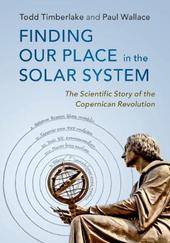
|
Finding our Place in the Solar System: The Scientific Story of the Copernican Revolution
Hardback
Main Details
| Title |
Finding our Place in the Solar System: The Scientific Story of the Copernican Revolution
|
| Authors and Contributors |
By (author) Todd Timberlake
|
|
By (author) Paul Wallace
|
| Physical Properties |
| Format:Hardback | | Pages:392 | | Dimensions(mm): Height 254,Width 178 |
|
| Category/Genre | History of science
Popular science
Solar system
Popular astronomy and space |
|---|
| ISBN/Barcode |
9781107182295
|
| Classifications | Dewey:521 |
|---|
| Audience | | Tertiary Education (US: College) | | General | |
|---|
| Illustrations |
Worked examples or Exercises; 60 Halftones, black and white; 50 Line drawings, black and white
|
|
Publishing Details |
| Publisher |
Cambridge University Press
|
| Imprint |
Cambridge University Press
|
| Publication Date |
28 March 2019 |
| Publication Country |
United Kingdom
|
Description
Finding our Place in the Solar System gives a detailed account of how the Earth was displaced from its traditional position at the center of the universe to be recognized as one of several planets orbiting the Sun under the influence of a universal gravitational force. The transition from the ancient geocentric worldview to a modern understanding of planetary motion, often called the Copernican Revolution, is one of the great intellectual achievements of humankind. This book provides a deep yet accessible explanation of the scientific disputes over our place in the solar system and the work of the great scientists who helped settle them. Readers will come away knowing not just that the Earth orbits the Sun, but why we believe that it does so. The Copernican Revolution also provides an excellent case study of what science is and how it works.
Author Biography
Todd Timberlake has taught physics and astronomy at Berry College, Georgia since 2001. He teaches courses on the Copernican Revolution, the history of galactic astronomy and cosmology, and extra-terrestrial life, among others. Although he usually teaches college students, he has taught audiences ranging from kindergarten children in the USA to Tibetan Buddhist monks in India. He is passionate about incorporating the history and philosophy of science into the teaching of science and he is an expert at using computers as a tool for teaching physics and astronomy. Paul Wallace teaches physics and astronomy at Agnes Scott College in Decatur, Georgia. His scientific work was in experimental nuclear physics and gamma-ray astrophysics, but his love of the history of astronomy drew him away from technical research. His unusual background and informal approach make him a sought-after speaker at churches, conferences, colleges, and retreats. His first book, Stars Beneath Us: Finding God in the Evolving Cosmos, was published in 2016.
Reviews'The story of understanding our Solar System is essentially a story of how science works. Finding Our Place in the Solar System connects the dots between observations of the movements of the Sun, the Moon and the stars on the celestial sphere to the scientific revolution brought about by Copernicus, Kepler, Galileo and ultimately Newton. Every chapter describes the key steps that led towards our current understanding of our Solar System, but also reflects on what these steps can tell us about how science in general works. The book, aimed at non-science-majors and the general public alike, motivates a very timely discussion on the dynamic and ever-changing nature of science.' Marios Karouzos, Nature Astronomy '... at the end of each section [is] a short chapter titled Reflections on science, a sort of philosophy of science light ... they are actually very well done and add, in my opinion, a lot to the value of the book as a teaching text ... Timberlake writes well and lucidly. His text is easy to read and his explanations are clear and straightforward. He covers the material well and I on the whole would thoroughly endorse his book as an excellent textbook and introduction to the history of European astronomy ... Timberlake's book is an excellent entry level introduction to the history of European mathematical astronomy as well as serving as an introduction to the process of science for non scientists and anybody looking to teach themselves or looking for a textbook for an advanced school class or a college level course should definitely consider using this volume ...' Thony C, The Renaissance Mathematicus '... the authors' ability to present complex scientific concepts in the history of astronomy and physics clearly and concisely is invaluable for undergraduate teaching. The figures, diagrams, and appendixes in the book enhance the clarity of their presentation, which was already impressive. This text will be very useful for those teaching the history of ancient, medieval, or early modern science. Even for those whose pedagogy differs markedly from that of Timberlake and Wallace, Finding Our Place in the Solar System could serve as a useful complement to the main themes of a course.' Nicholas A. Jacobson, Isis
|